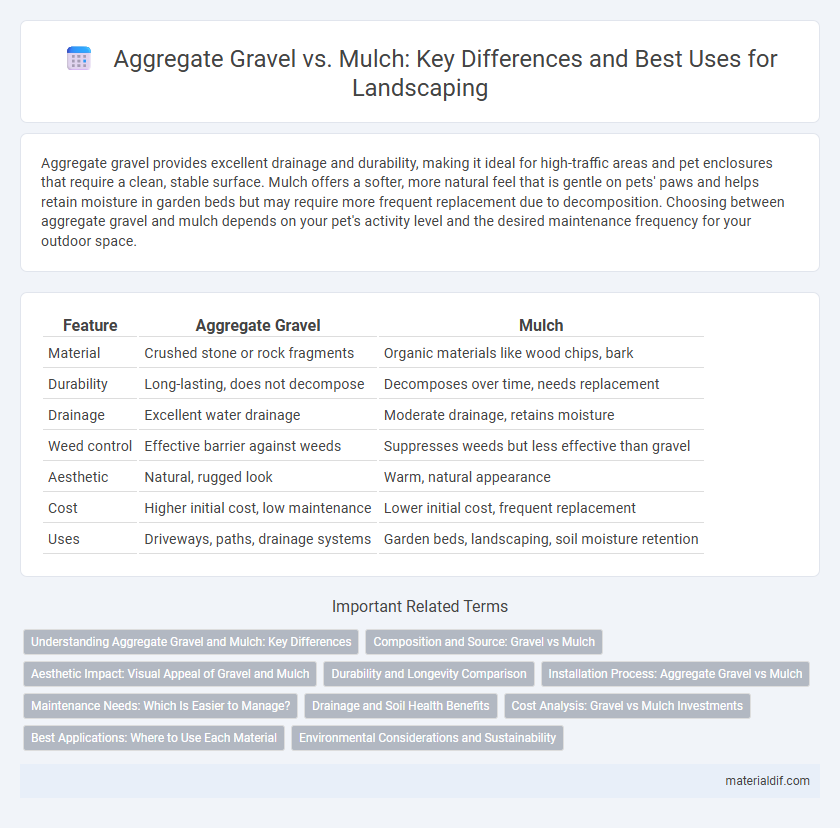Aggregate gravel provides excellent drainage and durability, making it ideal for high-traffic areas and pet enclosures that require a clean, stable surface. Mulch offers a softer, more natural feel that is gentle on pets' paws and helps retain moisture in garden beds but may require more frequent replacement due to decomposition. Choosing between aggregate gravel and mulch depends on your pet's activity level and the desired maintenance frequency for your outdoor space.
Table of Comparison
| Feature | Aggregate Gravel | Mulch |
|---|---|---|
| Material | Crushed stone or rock fragments | Organic materials like wood chips, bark |
| Durability | Long-lasting, does not decompose | Decomposes over time, needs replacement |
| Drainage | Excellent water drainage | Moderate drainage, retains moisture |
| Weed control | Effective barrier against weeds | Suppresses weeds but less effective than gravel |
| Aesthetic | Natural, rugged look | Warm, natural appearance |
| Cost | Higher initial cost, low maintenance | Lower initial cost, frequent replacement |
| Uses | Driveways, paths, drainage systems | Garden beds, landscaping, soil moisture retention |
Understanding Aggregate Gravel and Mulch: Key Differences
Aggregate gravel consists of crushed rock particles that provide durability, drainage, and stability for landscaping and construction projects, while mulch is made from organic materials like wood chips or bark that retain moisture and improve soil health. Gravel is preferred for pathways, driveways, and erosion control due to its long-lasting, non-decomposing nature, whereas mulch enhances plant growth by adding nutrients as it breaks down. Understanding these functional differences helps in selecting the right material for ground cover based on environmental needs and aesthetic preferences.
Composition and Source: Gravel vs Mulch
Aggregate gravel consists primarily of crushed rock such as granite, limestone, or quartz, sourced from quarries and processed to specific sizes for construction and landscaping. Mulch is an organic material derived from shredded bark, wood chips, or composted leaves, typically sourced from forestry byproducts or garden waste. Gravel's mineral composition provides durability and excellent drainage, while mulch offers moisture retention and nutrient benefits for soil health.
Aesthetic Impact: Visual Appeal of Gravel and Mulch
Aggregate gravel offers a sleek, modern visual appeal with its uniform texture and wide range of natural earth tones, enhancing landscape designs with a clean, polished look. Mulch provides a warm, organic aesthetic that complements garden beds and plantings, creating a softer, more natural environment. Both materials contribute distinct visual textures, with gravel emphasizing structure and mulch emphasizing natural warmth.
Durability and Longevity Comparison
Aggregate gravel offers superior durability and longevity compared to mulch due to its resistance to weathering, erosion, and decay. Unlike organic mulch, which breaks down and requires regular replenishment, gravel maintains its structural integrity for decades with minimal maintenance. This makes aggregate gravel a cost-effective option for long-term landscaping and ground cover needs.
Installation Process: Aggregate Gravel vs Mulch
Installing aggregate gravel involves spreading and leveling crushed stone or pebbles over a prepared surface with proper edging to maintain shape and prevent spreading. Mulch installation requires laying organic materials like wood chips or bark in a uniform layer around plants or garden beds, ensuring adequate depth for moisture retention and weed suppression. Gravel installation demands compacting and sometimes a geotextile fabric base to enhance stability, while mulch simply needs regular replenishment and aeration to maintain effectiveness.
Maintenance Needs: Which Is Easier to Manage?
Aggregate gravel requires less frequent upkeep than mulch, as it does not decompose or need regular replacement. Gravel resists weed growth and provides better drainage, reducing the need for constant maintenance. Mulch, while beneficial for soil health, demands periodic replenishment and can attract pests, increasing overall management efforts.
Drainage and Soil Health Benefits
Aggregate gravel offers superior drainage due to its larger, uniform particles that prevent water accumulation and promote faster runoff. Mulch, composed of organic materials, enhances soil health by retaining moisture, regulating temperature, and decomposing to add valuable nutrients. Choosing aggregate gravel improves site drainage, while mulch supports long-term soil fertility and microbial activity.
Cost Analysis: Gravel vs Mulch Investments
Gravel typically costs between $30 to $50 per ton, offering durability and low maintenance compared to mulch, which ranges from $20 to $60 per cubic yard but requires regular replenishment. Gravel's longevity reduces long-term replacement expenses, making it a cost-effective option for driveways and walkways. Mulch provides nutrient benefits for soil but demands ongoing investment and labor, impacting overall cost efficiency.
Best Applications: Where to Use Each Material
Aggregate gravel is ideal for drainage solutions, driveways, and pathways due to its durability and ability to prevent erosion. Mulch excels in garden beds and landscaping for moisture retention and weed suppression, enhancing soil health and plant growth. Choosing between the two depends on functional needs, with gravel providing structural stability and mulch offering organic soil benefits.
Environmental Considerations and Sustainability
Aggregate gravel is highly durable and allows for excellent water drainage, reducing erosion and preventing runoff pollution in landscaping projects. It is often sourced from natural rock deposits and can be recycled or reclaimed, minimizing environmental impact compared to the frequent replacement needed for mulch. Mulch, although renewable and beneficial for soil health by retaining moisture and suppressing weeds, decomposes rapidly and requires regular replenishment, which can contribute to increased resource use and carbon emissions.
Aggregate Gravel vs Mulch Infographic

 materialdif.com
materialdif.com